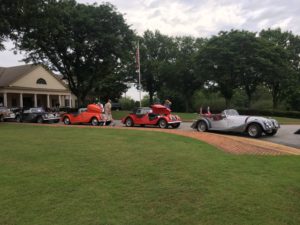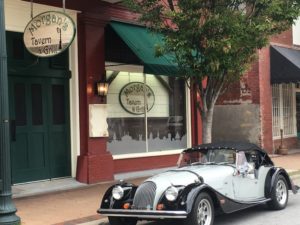In the case of Sir Charles Cheers Wakefield, later Baron Wakefield of Hythe, the sweet smell of success was more than a metaphor. You still catch the scent of the substance that made his company a household name in the early 1900s wherever older racing engines are exercised: that distinctive, heady perfume of Castrol R. Although castor oil, the origin of the smell, was still the purgative bane of many a childhood when C C Wakefield & Co introduced its Castrol range in 1909 (the name being a contraction of castor oil), to high performance engines on the road and in the air it was to become a more welcome part of the diet.
The story begins in 1899 when, having spent 15 years working for the London office of Vacuum Oil Company of Rochester, NY, later to metamorphose into Mobil, Charles Wakefield resigned his position as general manager and determined to strike out on his own. It was an auspicious time to be doing so. Within four years the Wright Brothers would take tentatively to the air, followed albeit somewhat belatedly by compatriot Samuel Franklin Cody at Famborough in 1908. A year later Louis Bleriot flew the English Channel and, five years after that, storm clouds over Europe would spur a period of unprecedented aircraft development effort. On the ground, progress was scarcely less momentous as the horseless carriage progressed from being a curiosity and plaything into an increasingly practical mechanism, as well as another vehicle of human endeavour and national rivalry.
Charles Wakefield wasn’t slow to realise that here lay both an important new market for lubricating oils and, just as significantly, a whole new marketing opportunity also. The world was agog at the daredevil exploits unfolding on land and in the air; having your product name attached to such derring do was a golden opportunity to exploit what today we would call product placement. So Charles Wakefield determined to produce a new breed of oil for this new breed of machine, and make certain that the world knew of it.
Engine oil development, like engine development itself, was then in its infancy. Today’s world of multigrade and synthetic oils was a long way off. Prior to the sinking of the first petroleum well in 1859, engineers had had to use animal and vegetable fats and oils for lubrication, but these proved far from ideal at the extremes of temperature involved in the internal combustion engine. As every cook knows, fats and oils thicken when you put them in the fridge and leave gummy, varnish-like deposits when you heat them in a pan. This same behaviour in an engine made cold cranking difficult on startup, while oxidation of the lubricant at combustion temperatures could, literally, gum up the works.
Mineral oils relieved these limitations, even in their early forms offering a level of thermal and oxidative stability traditional lubricants couldn’t match. But they were far from perfect In particular they lacked what, at the time, was termed “oiliness”, the ability to adhere to metal surfaces in a thin, continuous film. Wakefield researchers found that whereas castor oil coated a hot metal surface, mineral oil tended to pool on it, leaving areas of metal exposed.
Today we have a much better understanding of why this happens. Castor oil is composed almost entirely of triglyceride fatty acids, of which ricinoleic glycerides form by far the largest proportion (typically around 86 per cent). Fatty acids are polarised molecules comprising an oily, hydrophobic (water-hating) head and a hydrophilic (water-loving) tail; the hydrophilic ends of castor oil molecules are adsorbed to the metal surface, leaving the oily heads protruding.
The result is that castor oil provides excellent boundary lubrication, much better than that achieved by early mineral alternatives. In hydrodynamic bearings, like crankshaft bearings, where a relatively thick layer of oil is established, this offers no benefits. But where the oil layer is thin — on cylinder walls and cam lobes, for instance — it ensures a higher level of scuff resistance.
Mixing castor and mineral oil therefore seemed a good idea in the early 1900s, but the two are not readily miscible. What Wakefield researchers discovered was that a surprisingly small proportion of castor oil — as little as 0.7 per cent — was sufficient to confer its high film strength on the mix, and thus Wakefield Motor Oil (Castrol Brand) was born. In fact, five variants were introduced initially for different applications, Castrol R being the flagship product intended for aero and racing engines. Wakefield & Co’s core business was — and in the immediate future, would remain — lubricants for the railways and industrial customers, but it was Castrol Brand that was to carry the company name to the four corners of the globe.
Success was almost immediate. In October 1909, Britain’s first aviation prize, the Inauguration Cup, was won by Frenchman Leon Delagrange using Castrol oil. Following which, on land and in the air, the litany of Castrol successes encompasses many of the most significant events in aviation and motoring history, including Britain’s winning of the Schneider Trophy three times in a row with the R J Mitchell designed, Rolls-Royce powered Supermarine S5, and most of the World Land Speed Records established during the highly competitive inter-war years. In the Great War, Castrol R even came to the attention of Kaiser Wilhelm II, achieving almost ‘secret weapon’ status when it was discovered that a captured British aircraft could operate at considerably higher altitudes than German equivalents due to its engine oil’s superior low temperature performance.
In the 1920s castor oil was removed from general motoring oils as mineral oil technology advanced, but its superior film strength ensured it a continued role in high performance engines. Only in 1953 was Castrol R superseded by R20, again containing castor oil but this time mixed with a semi-synthetic, and the successes began all over again. Mercedes-Benz immediately chose it for the advanced W196, Fangio scoring a first-time-out victory for both oil and car when he won the French GP in ’54.
Even today castor oil remains the lubricant of choice in certain applications, notably methanol powered two-strokes because of its complete miscibility with alcohol fuels. As a result you don’t have to go to a historic race meeting to catch that distinctive castor aroma. Appropriately, it can even be smelt where enthusiasts fly model aeroplanes.



